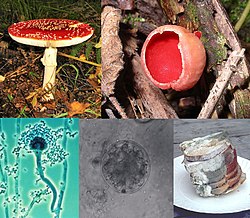
Back تطور الفطريات Arabic אבולוציה של פטריות HE Evolução dos fungos Portuguese Mantarların evrimi Turkish 真菌的进化 Chinese

Fungi diverged from other life around 1.5 billion years ago,[1][2] with the glomaleans branching from the "higher fungi" (dikaryans) at ~570 million years ago, according to DNA analysis. (Schüssler et al., 2001; Tehler et al., 2000)[2] Fungi probably colonized the land during the Cambrian, over 500 million years ago, (Taylor & Osborn, 1996),[2] and possibly 635 million years ago during the Ediacaran,[3][4] but terrestrial fossils only become uncontroversial and common during the Devonian, 400 million years ago.[2]
- ^ Wang, D.Y.C.; Kumar, S.; Hedges, S.B. (1999). "Divergence time estimates for the early history of animal phyla and the origin of plants, animals and fungi". Proceedings of the Royal Society of London B. 266 (1415): 163–171. doi:10.1098/rspb.1999.0617. PMC 1689654. PMID 10097391.
- ^ a b c d Brundrett M.C. (2002). "Coevolution of roots and mycorrhizas of land plants". New Phytologist. 154 (2): 275–304. doi:10.1046/j.1469-8137.2002.00397.x. PMID 33873429.
- ^ Gan, Tian; Luo, Taiyi; Pang, Ke; Zhou, Chuanming; Zhou, Guanghong; Wan, Bin; Li, Gang; Yi, Qiru; Czaja, Andrew D.; Xiao, Shuhai (December 2021). "Cryptic terrestrial fungus-like fossils of the early Ediacaran Period". Nature Communications. 12 (1): 641. doi:10.1038/s41467-021-20975-1. PMC 7843733. PMID 33510166.
- ^ "Paleontologists Find 635-Million-Year-Old Land Fungus-Like Fossils | Paleontology | Sci-News.com". Breaking Science News | Sci-News.com. Retrieved 2021-02-03.
© MMXXIII Rich X Search. We shall prevail. All rights reserved. Rich X Search